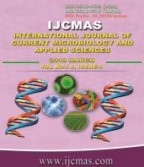


 National Academy of Agricultural Sciences (NAAS)
National Academy of Agricultural Sciences (NAAS)

|
PRINT ISSN : 2319-7692
Online ISSN : 2319-7706 Issues : 12 per year Publisher : Excellent Publishers Email : editorijcmas@gmail.com / submit@ijcmas.com Editor-in-chief: Dr.M.Prakash Index Copernicus ICV 2018: 95.39 NAAS RATING 2020: 5.38 |
In Nigeria, crude oil pollution challenge of the terrestrial environment is very prevalent. Soil fungi play very important role in the degradation of organic materials, as well as agents of the biogeochemical cycles. Fungi have an advantage over bacteria due to their production of hyphae that can penetrate contaminated soil. The aim of this study was to evaluate the bioremediation potential of two fungal species: Aspergillus clavatus and Pichia spp. Crude oil contaminated soil samples were collected from Numuu Mitee, Kegbara-Dere community in Gokana Local Government Area of Rivers State; Nigeria. There were four experimental setups for the bioremediation study; Soil without organisms served as control(A), soil with Aspergillus clavatus alone (B), soil sample with Pichia spp. alone (C), while soil with Aspergillus clavatus and Pichia spp combined (D). Standard microbiological methods were used to analyze total heterotrophic and hydrocarbon utilizing fungi. The following physicochemical parameters; pH, nitrate, phosphate, sulphate, and total hydrocarbon content (THC) were analysed for baseline and monitored every 7days for 28days. Molecular identification of the organisms was also carried out using 16S rRNA amplification. The results of the baseline were as follows; pH 6.9, nitrate 52mg/kg, phosphorus 149mg/kg, THC 8,006.58mg/kg, total heterotrophic fungi 3.8 x 104cfu/g and hydrocarbon utilizing fungi 2.3 x 103cfu/g. The results showed that the physicochemical parameters decreased significantly during the study period. The results of bioremediation indicates that the total hydrocarbon content of the soil in day 1 was 8006.58mg/kg but reduced in day 28 to 6799.74mg/kg for setup A, 3309.21mg/kg for B, 2835.53mg/kg for C and 1572.37mg/kg for D. The percentage THC loss was in this order: D>C>B>A, 80.36% > 64.59% > 58.67% > 15.07% respectively. This study reveals that using the Pichia species alone produced 64% THC loss while Aspergillus clavatus alone produced 58.6% loss. Combined potential of Aspergillus clavatus and Pichia spp. produced 80% reduction in 28days. This makes the consortium a more efficient option in bioremediation of crude oil contaminanted terrestrial soil.
 |
 |
 |
 |
 |